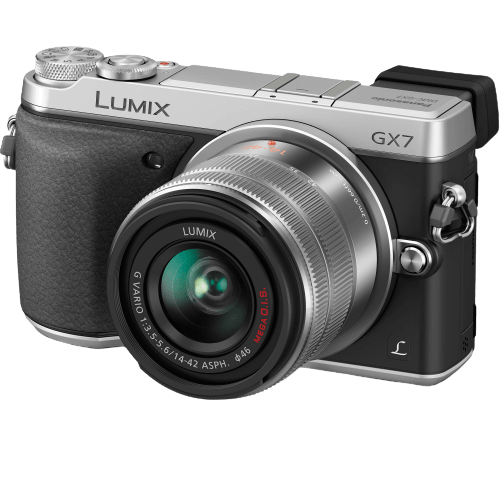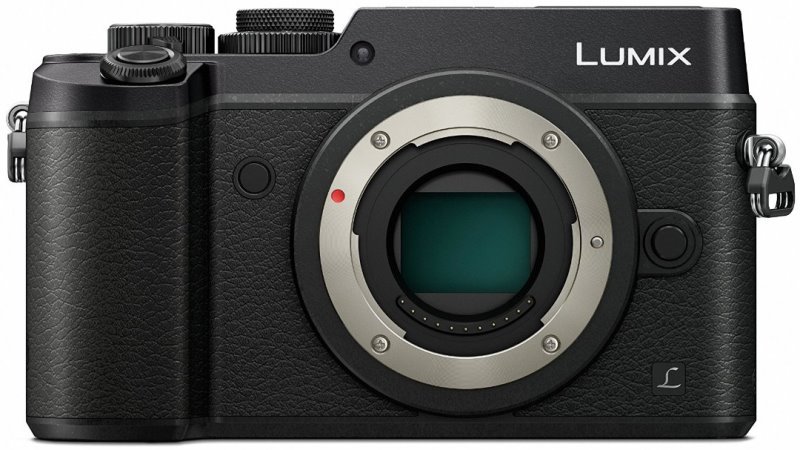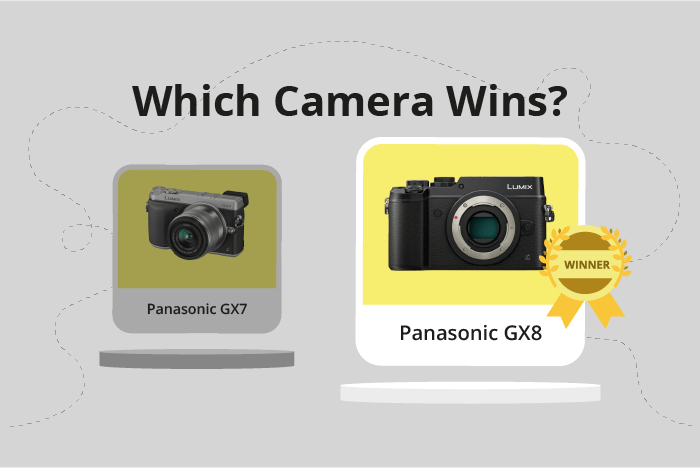Panasonic Lumix DMC-GX7 vs Lumix DMC-GX8 Comparison
Panasonic Lumix DMC-GX7

Panasonic Lumix DMC-GX8

The Panasonic Lumix DMC-GX8 takes the lead with a score of 63/100, while the Panasonic Lumix DMC-GX7 trails behind with 52/100. Both cameras are mirrorless and were released two years apart, with the GX7 in 2013 and the GX8 in 2015. They share similarities in size and weight, with the GX8 being slightly larger and heavier at 133 x 78 x 63mm and 487g, compared to the GX7’s 123 x 71 x 55mm and 402g.
The GX8’s higher score indicates better overall performance and features. However, the GX7 has an advantage in being lighter and more compact, which can be beneficial for portability. The GX8’s higher launch price of $1200 compared to the GX7’s $999 reflects the improvements made in the newer model.
Considering the points mentioned, the Panasonic Lumix DMC-GX8 outperforms the DMC-GX7, making it a better choice for those seeking advanced features and performance. However, the DMC-GX7 still offers a more affordable and portable option for those with budget and size constraints.
Panasonic Lumix DMC-GX7 vs Lumix DMC-GX8 Overview and Optics
The Panasonic Lumix DMC-GX8 takes the lead in optics with a score of 65/100, compared to the Panasonic Lumix DMC-GX7’s score of 54/100. Both cameras share several specifications, including a CMOS sensor type, Venus Engine processor, Micro Four Thirds sensor size, Micro 4/3 lens mount, and image stabilization.
The GX8’s superior optics score is due to its higher megapixel count of 20.3, compared to the GX7’s 16 megapixels. This increased resolution allows the GX8 to capture more detail and produce larger prints. Additionally, the GX8 has a faster shooting speed of 10 frames per second, compared to the GX7’s 5 frames per second. This enables the GX8 to capture fast-moving subjects more effectively. The GX8 also has a higher DXOMARK score for the sensor at 75, compared to the GX7’s score of 70, indicating better overall image quality.
Despite the lower optics score, the GX7 still has some advantages. It shares the same sensor size, lens mount, and image stabilization with the GX8, ensuring compatibility with a wide range of lenses and accessories. The GX7 also has a respectable megapixel count and shooting speed, making it suitable for a variety of photography scenarios.
Taking these factors into account, the Panasonic Lumix DMC-GX8 is the better choice for photographers seeking superior image quality and faster shooting speeds. However, the Panasonic Lumix DMC-GX7 remains a viable option for those looking for a more affordable camera with decent performance and compatibility with a wide range of lenses and accessories.
Panasonic Lumix DMC-GX7 vs Lumix DMC-GX8 Video Performance
The Panasonic Lumix DMC-GX8 outperforms the Panasonic Lumix DMC-GX7 in video capabilities with a 14-point advantage, scoring 70/100 compared to the GX7’s 56/100. Both cameras share some common video specifications, such as the ability to record in Full HD at 1920 x 1080 resolution. However, the similarities end there as the GX8 surpasses the GX7 in several aspects.
The winning camera, the GX8, boasts a 4K video resolution, offering significantly higher quality compared to the GX7’s maximum resolution of Full HD. With a max video dimension of 3840 x 2160, the GX8 provides more detailed and sharper video footage. Additionally, the GX8 has a built-in time-lapse functionality, allowing for creative video opportunities that the GX7 lacks.
On the other hand, the GX7 does have a higher maximum video frame rate of 60fps, compared to the GX8’s 25fps. This allows for smoother video playback, which can be beneficial for certain situations, such as capturing fast-moving subjects. However, this advantage is limited by the GX7’s lower resolution.
Taking into consideration the specifications, the Panasonic Lumix DMC-GX8 is the better choice for those prioritizing video capabilities. Its 4K resolution and time-lapse functionality provide superior quality and creative options. While the GX7 does offer a higher frame rate, the overall video performance of the GX8 makes it the clear winner in this comparison.
Panasonic Lumix DMC-GX7 vs Lumix DMC-GX8 Features and Benefits
The Panasonic Lumix DMC-GX8 emerges as the winner with a feature score of 70/100, compared to the Panasonic Lumix DMC-GX7’s score of 57/100. Both cameras share several specifications, such as a 3-inch screen size, 1,040,000-dot screen resolution, touchscreen capabilities, flip screen, GPS absence, WIFI, and lack of Bluetooth.
The higher feature score of the Lumix DMC-GX8 suggests that it has some advantages over the Lumix DMC-GX7. However, the shared specifications between the two cameras make it difficult to pinpoint specific areas in which the Lumix DMC-GX8 outshines the Lumix DMC-GX7 based on the given information.
On the other hand, the Lumix DMC-GX7 does not seem to have any significant advantages over the Lumix DMC-GX8. With a lower feature score and identical specifications in the areas mentioned above, it appears that the Lumix DMC-GX8 is a better camera in terms of features.
Considering the feature scores and specifications, the Panasonic Lumix DMC-GX8 stands out as the better camera. Although both cameras possess similar features, the Lumix DMC-GX8’s higher score indicates that it likely offers additional benefits not mentioned in the provided information. Meanwhile, the Lumix DMC-GX7 does not present any clear advantages, making it a less attractive option for potential buyers.
Panasonic Lumix DMC-GX7 vs Lumix DMC-GX8 Storage and Battery
The Panasonic Lumix DMC-GX7 and the Panasonic Lumix DMC-GX8 both receive a storage and battery score of 21/100. They share several specifications, including having one memory card slot and accepting SD, SDHC, and SDXC memory cards. Neither of these cameras support USB charging.
The Lumix DMC-GX7 has a slight advantage in battery life, providing 350 shots per charge compared to the GX8’s 330 shots. Its battery type is Li-Ion, 7.2V, 1200 mAh. On the other hand, the Lumix DMC-GX8 uses a DMW-BLC12 battery type, which doesn’t offer any notable improvement over the GX7’s battery.
In terms of storage and battery, there is no clear winner between these two cameras as they have almost identical specifications. The only minor difference is the slightly better battery life of the Lumix DMC-GX7. Therefore, potential buyers should base their decision on other factors and features of these cameras.
Alternatives to the Panasonic Lumix DMC-GX7 and Lumix DMC-GX8
Are you still undecided about which camera is right for you? Have a look at these popular comparisons that feature the Panasonic Lumix DMC-GX7 or the Panasonic Lumix DMC-GX8:

